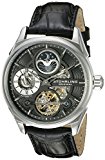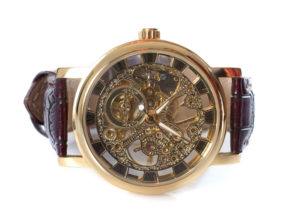How to Find the Best Skeleton Watch
Skeleton watches are a mechanical watch, but with an open aesthetic design. This allows you to be able to see all of the moving parts of the watch through the front, back, or some other window that is built into the watches’ design.
Many manufacturers have taken advantage of the popularity of skeleton watches to mimic their look with an affordable design. It is important to note that a true skeleton watch will have trimmed away all non-essential metal on the wheel train, plate, bridge, and other mechanical parts of the watch so that a minimalistic design and movement is offered.
Here are some more important tips to help you be able to find the best skeleton watch to meet your needs.
#1. Price is a definite indicator of value.
You are not going to find a non-Chinese manufactured skeleton watch today for less than $300. This doesn’t mean that you can’t get a great watch that was assembled in China. It just means that for an authentic movement and wear experience, you’re going to need to look at the price as an indicator of the value that you’ll receive.

Here’s an example: the OrisArtelier skeleton watch, which features Swiss movements.
#2. Know your manufacturers.
The problem with many skeleton watches is that they lack definition in design. You can tell that it’s a skeleton watch when you look at it. Someone at a distance will not know that you’re wearing a skeleton watch from a distance, especially if you’re wearing a fashion brand like Emporio Armani.

Other brands, including Fossil and those that license to their manufacturing process, will also make affordable skeleton watches in the $100-$200 range.
#3. Pay attention to the features provided by the watch.
The best skeleton watches will do more than help you keep track of time in a stylish way. There should also be certain features included with the watch so that you can maximize the wearing experience. Here are the top features we would recommend looking for if you’re interested in this type of timepiece.
- It should be water-resistant. The minimum depth of water-resistance should be 50 meters. The best skeleton watches will be water resistant up to 600 meters and function as a practical dive watch.
- It should offer automatic movements. Most skeleton watches are automatic or kinetic in design, but should also be able to be wound manually if need be. Stuhrling gets this right by having you be able to turn the crown clockwise 20-30 times to be able to wind the movement.
- It should offer a sapphire crystal. To keep the retail prices of the best skeleton watches low, many manufacturers have transitioned to mineral glass crystals for their timepieces. Although it adds up to $300 to the MSRP of the watch, a sapphire crystal is your best option to avoid scratching. If impacts are more of your worry than scratching, then look for a crystal that is shatter-resistant.
#4. Look for Japanese movements if you want to save $$.
Miyota movements are your best option if you’re looking for an affordable skeleton watch. There are several sub-$100 skeleton watches that feature these Japanese movements, which is similar to what you’d find in the best Citizen watches. Many timepieces in this category that are in the $50-$100 range actually feature Hangzhou movements, which are not as reliable.
Some may just be concerned about the actual look of the watch and the movements may not matter. At the end of the day, however, a watch is only as good as the time it can tell. If you can find Japanese movements in a skeleton design that still doesn’t break your budget, then that’s your best option.
#5. Count the number of jewels.
As with the older pocket watches, the best skeleton watch tends to feature automatic movements. This means the accuracy of those movements is dependent on the quality of the internal mechanisms. Each “jewel” is a representation of hardened materials when there is gear-on-gear action within the watch.
For a high-quality skeleton watch, there should be at least 21-jewel movement. Anything less may offer time inaccuracy. High-end movements may feature 35+ jewel movement.
Some designs may feature battery operations or other forms of movement that do not require jewels. Just beware of some skeleton watches that try to disguise the fact that they feature automatic movements with a low jewel count to avoid making a poor investment.
#6. Be aware that you may need to replace the strap.
One of the biggest complaints about skeleton watches doesn’t come from the quality of the watch itself. The issue lies in the stock straps that are often used, coming from mass production efforts. They don’t tend to stand up well to daily wear and the rubber ones can pinch, rub, and even pull out your arm hairs if they move a little. Then there’s the sweat retention issue.
The good news is that replacing the strap on a skeleton watch is a problem that is easy to fix. In most cases, it won’t void the limited warranty you have on the watch either.
We really love these NATO straps.
Just remember to purchase the correct lug width for your watch.
The best skeleton watch will help you keep track of time in a fashionable way. Look for 316L stainless steel or titanium cases for best results. Then remember the cost: if you want to avoid APAC manufacturing and want Swiss or German movements, then you’re going to be paying 4 figures for your timepiece.
With some selective shopping and access to watch reviews, you can also find a great watch at a much lower price – especially with tips like these.
Last update on 2020-09-25 / Images from Amazon Product Advertising API



